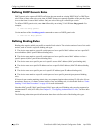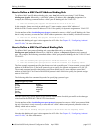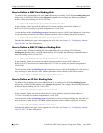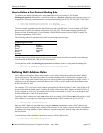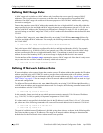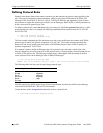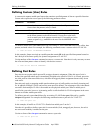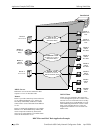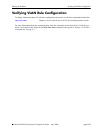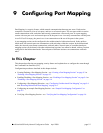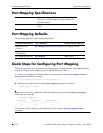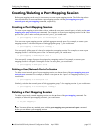
Application Example: DHCP Rules Defining VLAN Rules
page 8-22 OmniSwitch 6600 Family Network Configuration Guide April 2006
Application Example: DHCP Rules
This application example shows how Dynamic Host Configuration Protocol (DHCP) port and MAC
address rules are used in a DHCP-based network. DHCP is built on a client-server model in which a desig-
nated DHCP server allocates network addresses and delivers configuration parameters to dynamically
configured clients.
Since DHCP clients initially have no IP address, assignment of these clients to a VLAN presents a prob-
lem. The switch determines VLAN membership by looking at traffic from source devices. Since the first
traffic transmitted from a source DHCP client does not contain the actual address for the client (because
the server has not allocated the address yet), the client may not have the same VLAN assignment as its
server.
Before the introduction of DHCP port and MAC address rules, various strategies were deployed to use
DHCP with VLANs. Typically these strategies involved IP protocol and network address rules along with
DHCP Relay functionality. These solutions required the grouping of all DHCP clients in a particular
VLAN through a common IP policy.
DHCP port and MAC address rules simplify the configuration of DHCP networks. Instead of relying on
IP-based rules to group all DHCP clients in the same network as a DHCP server, you can manually place
each individual DHCP client in the VLAN or mobile group of your choice.
The VLANs
This application example contains three (3) VLANs. These VLANs are called Test, Production, and
Branch. The Test VLAN connects to the main network, the Production VLAN, through an external router.
The configuration of this VLAN is self-contained, making it easy to duplicate for testing purposes. The
Test VLAN contains its own DHCP server and DHCP clients. The clients gain membership to the VLAN
through DHCP port rules.
The Production VLAN carries most of the traffic in this network. It does not contain a DHCP server, but
does contain DHCP clients that gain membership through DHCP port rules. Two external routers connect
this VLAN to the Test VLAN and a Branch VLAN. One of the external routers—the one connected to the
Branch VLAN—has DHCP Relay functionality enabled. It is through this router that the DHCP clients in
the Production VLAN access the DHCP server in the Branch VLAN.
The Branch VLAN contains a number of DHCP client stations and its own DHCP server. The DHCP
clients gain membership to the VLAN through both DHCP port and MAC address rules. The DHCP server
allocates IP addresses to all Branch and Production VLAN clients.
DHCP Servers and Clients
DHCP clients must communicate with a DHCP server at initialization. The most reliable way to ensure
this communication is for the server and its associated clients to share the same VLAN. However, if the
network configuration does not lend itself to this solution (as the Production VLAN does not in this appli-
cation example), then the server and clients can communicate through a router with DHCP Relay enabled.
The DHCP servers and clients in this example are either in the same VLAN or are connected through a
router with DHCP Relay. All clients in the Test VLAN receive IP addresses from the server in their
VLAN (Server 1). Likewise, all clients in the Branch VLAN receive IP addresses from their local server
(Server 2). The DHCP clients in the Production VLAN do not have a local DHCP server, so they must rely
on the DHCP Relay functionality in external Router 2 to obtain their IP addresses from the DHCP server
in the Branch VLAN.
Both DHCP servers are assigned to their VLANs through IP network address rules.



